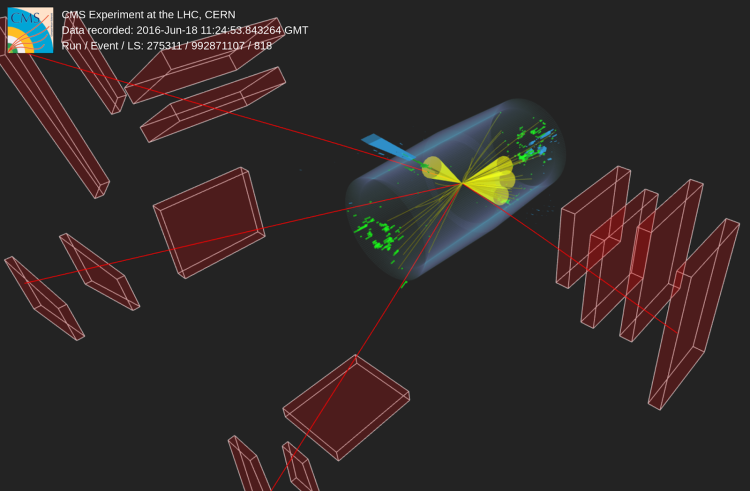
The CMS Collaboration has recently reported a new study of ZZ+jets production, a process described by the Standard Model of particle physics. The goal of such measurements is to compare the observed results with the theoretical predictions; any discrepancies may be a hint of physics beyond the Standard Model or an indication that there is still room for improvement in the theoretical calculations.
The ZZ production process, where each Z boson decays to two electrons or two muons, is one of the final states exploited to discover the Higgs boson in 2012. Once we accumulated more data, we were able to use this channel to perform precision measurements, with several thousands of recorded events. These events may also contain jets -- collimated streams of particles produced in high-energy processes, as in the example event shown at the top, shown again in the next figure in an interactive version (you can rotate it and zoom in or out).
Why are they interesting? From a theoretical perspective, jets are the outcome of the “hadronization” of high energy quarks or gluons produced in the collisions. The probability of creating such hard partons is proportional to the strong coupling constant αs, which quantifies the strength of the strong interaction and is of the order of ~0.1 at the energy scale of typical high-energy collider experiments. We say that every additional hard parton produced in a proton-proton collision adds “one order of αs” into the theoretical calculation. As the order increases, the calculation becomes more and more complex, and it takes several years before the theorists move from one order to the next. Analyzing events at different jet multiplicities allows us to estimate the “orders” that are required for the theoretical calculation to give predictions compatible in precision with the measurements. This is an essential step as we investigate final states of ever-increasing complexity, in our path to improve our detailed understanding of the Standard Model, and in our searches for new physics.
Figure 1: Mass distribution of the four-lepton final state, without selecting events on the basis of the number of emitted jets.
Figure 1 shows the distribution of the invariant mass of the four-lepton system reconstructed in the collected events. This distribution is a kind of identity picture for elementary particles: for each particle there is a peak at the mass of that particle (which we call a “resonance”). We see a peak at 90 GeV, corresponding to events where a single Z boson decays directly to four leptons [1], and a peak at the Higgs boson mass, 125 GeV, from events with a Higgs boson decaying to a pair of Z bosons [2], that then lead to the four leptons. The broad bump at higher masses reflects the existence of events where the pair of Z bosons is created directly in the pp collisions rather than as the result of the decay of heavier particles. In the case of the distribution shown in Fig. 1, where no requirement is applied on the number of jets, the measurement is reasonably well described by the theoretical predictions.
Figure 2: Differential distribution of four-lepton invariant mass in events with 4 or more jets.
Figure 2 shows the analogous distribution when we only select events with four or more jets. We see that, in this case, there are significant differences between the experimental data and the theory predictions. We need to be sure that these discrepancies cannot be attributed to the effects of higher-order contributions before considering them in the context of searcher for physics beyond the Standard Model. With larger data samples we will be able to perform more precise measurements. In parallel, theoretical predictions are expected to become more precise, thanks to the work of theoretical physicists, so that we can proceed in our path towards a deeper understanding of the physics of elementary particles.
1: CMS-SMP-16-017; Eur. Phys. J. C 78 (2018) 165
https://cms-results.web.cern.ch/cms-results/public-results/publications/SMP-16-017/index.html
2: CMS-HIG-19-001; Eur. Phys. J. C 81 (2021) 488
https://cms-results.web.cern.ch/cms-results/public-results/publications/HIG-19-001/index.html
Read more about these results:
-
CMS Physics Analysis Summary "Measurement of the differential ZZ+jets production cross sections in pp collisions at 13 TeV"
-
@CMSExperiment on social media: facebook - twitter - instagram
- Do you like these briefings and want to get an email notification when there is a new one? Subscribe here

